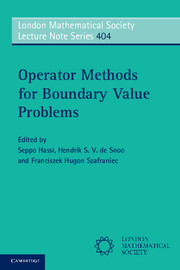Book contents
- Frontmatter
- Contents
- List of contributors
- Preface
- 1 John Williams Calkin: a short biography
- 2 On Calkin's abstract symmetric boundary conditions
- 3 Boundary triplets and maximal accretive extensions of sectorial operators
- 4 Boundary control state/signal systems and boundary triplets
- 5 Passive state/signal systems and conservative boundary relations
- 6 Elliptic operators, Dirichlet-to-Neumann maps and quasi boundary triples
- 7 Boundary triplets and Weyl functions. Recent developments
- 8 Extension theory for elliptic partial differential operators with pseudodifferential methods
- 9 Dirac structures and boundary relations
- 10 Naĭmark dilations and Naĭmark extensions in favour of moment problems
- References
10 - Naĭmark dilations and Naĭmark extensions in favour of moment problems
Published online by Cambridge University Press: 05 November 2012
- Frontmatter
- Contents
- List of contributors
- Preface
- 1 John Williams Calkin: a short biography
- 2 On Calkin's abstract symmetric boundary conditions
- 3 Boundary triplets and maximal accretive extensions of sectorial operators
- 4 Boundary control state/signal systems and boundary triplets
- 5 Passive state/signal systems and conservative boundary relations
- 6 Elliptic operators, Dirichlet-to-Neumann maps and quasi boundary triples
- 7 Boundary triplets and Weyl functions. Recent developments
- 8 Extension theory for elliptic partial differential operators with pseudodifferential methods
- 9 Dirac structures and boundary relations
- 10 Naĭmark dilations and Naĭmark extensions in favour of moment problems
- References
Summary
Abstract Making use of Naĭmark extensions of a symmetric operator arising from an indeterminate Hamburger moment sequence we manufacture a machinery for providing representing measures with the following properties
1o the support of each of them is in arithmetic progression;
2o the supports of all the measures together partition ℝ;
3o none of them is N-extremal;
4o all of them are of infinite order.
All this is based on and, in fact, is a kind of guide to [Cichoń, Stochel and Szafraniec, 2010].
Moment problems and their close relatives, orthogonal polynomials were pretty often treated by the same means, mostly continuous fractions. Then, starting from [Stone, 1932, Chapter X] operator theory was used to handle the problem, look at [Landau, 1980] and [Fuglede, 1983, especially p. 51] for further references as well as for a fairly decent introduction to the subject, in a contemporary language.
Sustaining this idea in what refers to the single real variable case, sooner or later one has to deal with a symmetric operator which, as a matter of course, has deficiency indices (0, 0) or (1, 1). The latter is of interest here as it corresponds to an indeterminate moment problem and the routine procedure is to pass to extensions in the same Hilbert space as they always have to exist. The other way, which seems to be much less exploited with some exceptions, like [Kreĭn and Krasnoselskiĭ, 1947; Gil de Lamadrid, 1971; Langer, 1976; Simon, 1998] and references therein, is to go for extensions beyond the space.
- Type
- Chapter
- Information
- Operator Methods for Boundary Value Problems , pp. 275 - 298Publisher: Cambridge University PressPrint publication year: 2012
References
- 1
- Cited by



